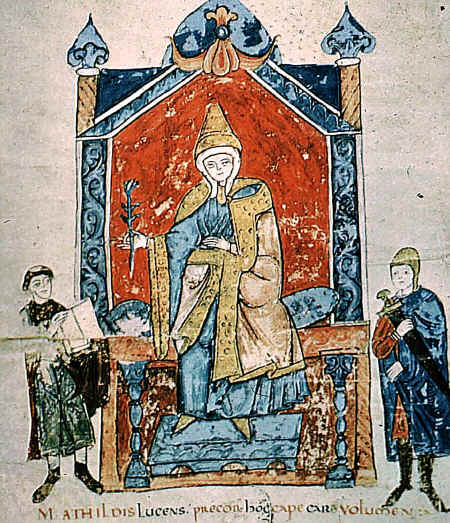Matilda of Tuscany (1046-1115) ruled over a vast territory in northern Italy and played a major role in the Investiture Controversy, supporting Pope Gregory VII and his reform party in their struggle against the German Emperor Henry IV. She was the sole surviving child of Boniface of Canossa and Beatrix, daughter of Frederick II of Lorraine. After Boniface’s death in 1052, Beatrix married her cousin Godfrey the Bearded of Lorraine, a close kinsman of several contemporary reform popes. Just before her stepfather’s death in 1069, the young Matilda married his son, Godfrey the Hunchback. Matilda left him after only two years in his duchy of Lorraine, refusing all efforts at reconciliation. She returned to her mother in Italy and began to share the duties of the ducal office. As tensions grew between pope and emperor over who had the right to appoint bishops, the ladies of Canossa attempted to mediate. In 1076, the unsolved murder of her estranged husband left Matilda a widow, while her mother’s death left her sole ruler of Tuscany. The following year Matilda hosted the famous reconciliation between Henry IV and Gregory VII at her own stronghold in Canossa.
The peace was short-lived. When mediation failed, Matilda sided unwaveringly with Pope Gregory. In 1081 the emperor marched into Italy and declared Matilda’s lands forfeit. For nearly two decades Matilda struggled against imperial forces and occasionally her own rebellious subjects to regain and hold her lands. Her court became a refuge for exiled Gregorian bishops, including Anselm of Lucca, who became Matilda’s chief spiritual advisor. After many defeats, a victory in 1084 helped her gradually to win back her towns, although she never regained her full domain. Aside from a brief and mutually unsatisfactory second marriage to Welf, teenage son of the duke of Bavaria, the last decades of Matilda’s rule were less turbulent. In 1111 she officially reconciled with the new emperor, Henry V. Matilda died in 1115 at the age of sixty-nine, leaving generations of emperors and popes to fight over the right to her vast fortunes.
Matilda’s rule was not an unmitigated success. Her domain was considerably smaller at her death than at her accession. She alienated many of her barons, in part through her support for the Pataria, a populist religious reform movement. Although she was in part responsible for the successes of the Gregorian faction, she did not so much defeat her enemies as outlast them. Nevertheless, she retained in a strong if diminished position for nearly forty years. Her influence was widely felt, from the election of popes to the dissemination of Gregorian political propaganda to the movements of the emperor’s armies.
Matilda is a particularly remarkable figure in women’s history. At a time when most powerful women achieved their status through marriage, Matilda ruled over an inherited domain in her own right and managed to keep it out of the hands of both of her husbands. That she was able to extricate herself relatively painlessly from both marriages, though inviting the enmity of two powerful ducal houses in the process, points to the strength of her position. All evidence suggests that Matilda ruled with the same authority as her male counterparts, holding law courts, settling disputes, and levying armies. She took an active role in her military campaigns, and some contemporary sources claim that she led her own armies into battle.
In spite of her worldly accomplishments, Matilda nourished a life-long yearning for the religious life. The duties of marriage followed by the weighty responsibilities of rulership prevented her from realizing her desire. She accepted that she was needed in the secular world, fighting the “heretics and schismatics.” This tension between the active and contemplative life, one longed for, the other undertaken out of duty, characterizes many contemporary portrayals of the countess. She strove to reconcile a life of pious spirituality with a life of leadership and warfare, making her a perfect heroine for a reform movement that was rooted in monastic ideals but condoned bloodshed on behalf of the Church. Matilda may have embraced this role as champion of the Church and “daughter of St. Peter” (symbol of the papacy) in part for the special legitimacy it conferred upon her, for the extent of her power and influence was largely unprecedented for women of her era. Her sex does not seem to have impeded her exercise of authority, yet she must have felt some uncertainty about her official position, as expressed in her subscription on official documents: “Matilda, by the grace of God, whatever I am.”
References and Further Reading Donizo of Canossa. Vita Mathildis celeberrimae principis Italiae carmine scripta a Donizone presbytero qui in arce canusina vixit, edited by Luigi Simeoni. Bologna: N. Zanichelli, 1940. Duff, Nora. Matilda of Tuscany, la gran donna d’Italia. London: Methuen & Company, 1909. Ghirardini, Lino Lionello. Storia critica di Matilde di Canossa: Problemi (e misteri) della piu’ grande donna della storia d’Italia. Modena: Aedes Muratoriana, 1989. Goez, Elke and Werner Goez, eds. Die Urkunden und Briefe der Markgräfin Mathilde von Tuszien. Hannover: Hahnsche Buchhandlung, 1998. Goez, Werner. “Markgräfin Mathilde von Canossa.” In Lebensbilder aus dem Mittelalter: Die Zeit der Ottonen, Salier und Staufer, Darmstadt: Primus, 1998, pp. 233-254. Overmann, Alfred. Gräfin Mathilde von Tuscien: Ihre Besitzungen. Geschichte ihres Gutes von 1115-1230 und ihre Regesten. Innsbruck: Verlag der Wagner’schen Universita “ts-Buchhanoling, 1895. Reynolds, Rosalind Jaeger. “Reading Matilda: The Self- Fashioning of a Duchess.” Essays in Medieval Studies 19 (2002): 1-13. Studi matildici: atti e memorie del III Convegno di studi matildici, Reggio-Emilia, 7-8-9 ottobre 1977. Modena: Aedes Muratoriana, 1978.
